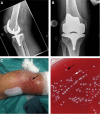Clinical Significance and Pathogenesis of Staphylococcal Small Colony Variants in Persistent Infections
- PMID: 26960941
- PMCID: PMC4786882
- DOI: 10.1128/CMR.00069-15
Clinical Significance and Pathogenesis of Staphylococcal Small Colony Variants in Persistent Infections
Abstract
Small colony variants (SCVs) were first described more than 100 years ago for Staphylococcus aureus and various coagulase-negative staphylococci. Two decades ago, an association between chronic staphylococcal infections and the presence of SCVs was observed. Since then, many clinical studies and observations have been published which tie recurrent, persistent staphylococcal infections, including device-associated infections, bone and tissue infections, and airway infections of cystic fibrosis patients, to this special phenotype. By their intracellular lifestyle, SCVs exhibit so-called phenotypic (or functional) resistance beyond the classical resistance mechanisms, and they can often be retrieved from therapy-refractory courses of infection. In this review, the various clinical infections where SCVs can be expected and isolated, diagnostic procedures for optimized species confirmation, and the pathogenesis of SCVs, including defined underlying molecular mechanisms and the phenotype switch phenomenon, are presented. Moreover, relevant animal models and suggested treatment regimens, as well as the requirements for future research areas, are highlighted.
Copyright © 2016, American Society for Microbiology. All Rights Reserved.
Figures







References
-
- Kolle W, Hetsch H. 1906. Die experimentelle Bakteriologie und die Infektionskrankheiten mit besonderer Berücksichtigung der Immunitätslehre. Ein Lehrbuch für Studierende, Ärzte und Medizinalbeamte. Urban & Schwarzenberg, Berlin, Germany.
-
- Borderon E, Horodniceanu T. 1976. Mutants déficients a colonies naines de Staphylococcus: étude de trois souches isolées chez des malades porteurs d'ostéosynthèses. Ann Microbiol (Paris) 127:503–514. - PubMed
-
- Spink WW, Osterberg K, Finstad J. 1962. Human endocarditis due to a strain of CO2-dependent penicillin-resistant staphylococcus producing dwarf colonies. J Lab Clin Med 59:613–619. - PubMed
Publication types
MeSH terms
LinkOut - more resources
Full Text Sources
Other Literature Sources
Medical
Miscellaneous

